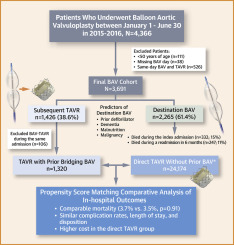当前位置:
X-MOL 学术
›
JACC Cardiovasc. Inte.
›
论文详情
Our official English website, www.x-mol.net, welcomes your
feedback! (Note: you will need to create a separate account there.)
Balloon Aortic Valvuloplasty as a Bridge to Aortic Valve Replacement: A Contemporary Nationwide Perspective.
JACC: Cardiovascular Interventions ( IF 11.7 ) Pub Date : 2020-02-05 , DOI: 10.1016/j.jcin.2019.11.041 Akram Kawsara 1 , Fahad Alqahtani 2 , Mackram F Eleid 3 , Abdallah El-Sabbagh 4 , Mohamad Alkhouli 3
JACC: Cardiovascular Interventions ( IF 11.7 ) Pub Date : 2020-02-05 , DOI: 10.1016/j.jcin.2019.11.041 Akram Kawsara 1 , Fahad Alqahtani 2 , Mackram F Eleid 3 , Abdallah El-Sabbagh 4 , Mohamad Alkhouli 3
Affiliation

|
OBJECTIVES
This study sought to use a national representative database to assess the incidence, predictors, and outcomes of balloon aortic valvuloplasty (BAV) as a bridge to transcatheter aortic valve replacement (TAVR) in contemporary practice.
BACKGROUND
Nationwide data on the use and outcomes of BAV as a bridge to TAVR are limited.
METHODS
Patients who underwent BAV between January and June in 2015 and 2016 were identified in the National Readmission Database. We assessed rate of subsequent TAVR following BAV, and predictors and timing of subsequent TAVR. We then identified a group of patients who had direct TAVR (without prior BAV) in the original 2015 to 2016 National Readmission Database dataset. We compared in-hospital outcomes following TAVR between patients with prior bridging BAV and those undergoing direct TAVR.
RESULTS
Among the 3,691 included patients 1,426 (38.6%) had subsequent TAVR. Timing of TAVR was pre-discharge in 7.4%, within 30 days in 35%, between 31 and 90 days in 47%, between 91 and 180 days in 14%, and >180 days in 4%. Negative predictors of subsequent TAVR included prior defibrillator (odds ratio [OR]: 0.56; 95% confidence interval [CI]: 0.36 to 0.85), dementia (OR: 0.60; 95% CI: 0.46 to 0.79), malnutrition (OR: 0.64; 95% CI: 0.45 to 0.90), and malignancy (OR: 0.62; 95% CI: 0.47 to 0.82). In propensity-score matched cohorts of patients who underwent direct TAVR versus those with prior BAV, in-hospital mortality during TAVR admission was similar (3.7% vs. 3.5%; p = 0.91). Major complications, length of stay, and discharge disposition were also comparable. However, cost of the hospitalization was higher in the direct TAVR group.
CONCLUSIONS
About 40% of BAV patients undergo subsequent TAVR mostly within 90 days. In-hospital outcomes of TAVR in these patients were comparable with propensity-score matched patients who underwent TAVR without prior BAV. Further investigations are needed to define the role of BAV in contemporary practice.
中文翻译:

球囊主动脉瓣膜成形术是通向主动脉瓣置换的桥梁:当代全国视野。
目的本研究试图使用全国代表性的数据库来评估球囊主动脉瓣膜成形术(BAV)的发生率,预测因素和结果,以作为现代实践中经导管主动脉瓣膜置换术(TAVR)的桥梁。背景技术关于BAV作为通往TAVR的桥梁的用途和结果的全国性数据是有限的。方法在2015年1月至6月的2016年1月至6月间接受BAV的患者在美国国家再入院数据库中进行鉴定。我们评估了BAV之后的后续TAVR的发生率,预测指标和后续TAVR的时序。然后,我们在最初的2015年至2016年国家再入院数据库数据集中确定了一组直接接受TAVR(无先前BAV)的患者。我们比较了先行BAV的患者和接受直接TAVR的患者在TAVR后的住院结局。结果在3个结果中,691例患者中有1,426例(38.6%)接受了TAVR。TAVR的时间安排为:提前放电的比例为7.4%,在30天内为35%,在31至90天之间为47%,在91至180天之间为14%,而在180%以上为4%。后续TAVR的阴性预测指标包括先前的除颤器(赔率[OR]:0.56; 95%置信区间[CI]:0.36至0.85),痴呆(OR:0.60; 95%CI:0.46至0.79),营养不良(OR:0.64) ; 95%CI:0.45至0.90)和恶性肿瘤(OR:0.62; 95%CI:0.47至0.82)。在接受直接TAVR的患者与有先前BAV的患者的倾向评分匹配队列中,TAVR入院期间的院内死亡率相似(3.7%vs. 3.5%; p = 0.91)。主要并发症,住院时间和出院情况也相当。但是,直接TAVR组的住院费用较高。结论大约40%的BAV患者大部分在90天内进行了随后的TAVR。在这些患者中,TAVR的院内结局与未经TAV接受TAVR的倾向评分匹配患者相当。需要进一步的研究来确定BAV在当代实践中的作用。
更新日期:2020-02-12
中文翻译:

球囊主动脉瓣膜成形术是通向主动脉瓣置换的桥梁:当代全国视野。
目的本研究试图使用全国代表性的数据库来评估球囊主动脉瓣膜成形术(BAV)的发生率,预测因素和结果,以作为现代实践中经导管主动脉瓣膜置换术(TAVR)的桥梁。背景技术关于BAV作为通往TAVR的桥梁的用途和结果的全国性数据是有限的。方法在2015年1月至6月的2016年1月至6月间接受BAV的患者在美国国家再入院数据库中进行鉴定。我们评估了BAV之后的后续TAVR的发生率,预测指标和后续TAVR的时序。然后,我们在最初的2015年至2016年国家再入院数据库数据集中确定了一组直接接受TAVR(无先前BAV)的患者。我们比较了先行BAV的患者和接受直接TAVR的患者在TAVR后的住院结局。结果在3个结果中,691例患者中有1,426例(38.6%)接受了TAVR。TAVR的时间安排为:提前放电的比例为7.4%,在30天内为35%,在31至90天之间为47%,在91至180天之间为14%,而在180%以上为4%。后续TAVR的阴性预测指标包括先前的除颤器(赔率[OR]:0.56; 95%置信区间[CI]:0.36至0.85),痴呆(OR:0.60; 95%CI:0.46至0.79),营养不良(OR:0.64) ; 95%CI:0.45至0.90)和恶性肿瘤(OR:0.62; 95%CI:0.47至0.82)。在接受直接TAVR的患者与有先前BAV的患者的倾向评分匹配队列中,TAVR入院期间的院内死亡率相似(3.7%vs. 3.5%; p = 0.91)。主要并发症,住院时间和出院情况也相当。但是,直接TAVR组的住院费用较高。结论大约40%的BAV患者大部分在90天内进行了随后的TAVR。在这些患者中,TAVR的院内结局与未经TAV接受TAVR的倾向评分匹配患者相当。需要进一步的研究来确定BAV在当代实践中的作用。











































 京公网安备 11010802027423号
京公网安备 11010802027423号